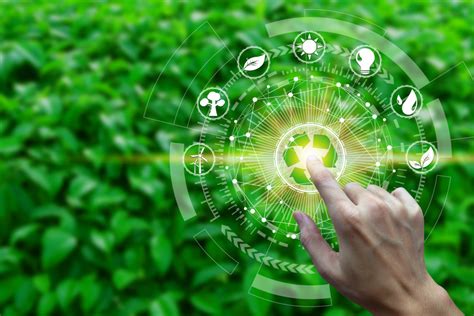What is green technology?
Green technology, also known as environmental technology or cleantech, refers to the development and application of products, services, and processes that are more environmentally friendly and sustainable. It encompasses various sectors such as energy, transportation, waste management, water conservation, and more. The main objective of green technology is to minimize the negative impact on the environment and promote the conservation of natural resources.
One of the key aspects of green technology is its focus on renewable energy sources. Renewable energy refers to energy derived from natural resources that are constantly replenished, such as sunlight, wind, and water. Green technology solutions in renewable energy aim to harness these sources in a clean and efficient manner, reducing reliance on fossil fuels and reducing greenhouse gas emissions.
Another crucial area where green technology plays a significant role is waste management. Waste management involves the collection, transportation, processing, and disposal of waste materials in an environmentally friendly manner. Innovative green technology for waste management includes techniques such as recycling, composting, and waste-to-energy conversion, which help reduce landfill waste and minimize pollution.
Benefits of adopting green technology
Green technology refers to the use of environmentally friendly practices, products, and technologies to conserve resources and reduce the negative impact on the environment. It focuses on creating sustainable solutions that promote a healthier planet and a better future for generations to come. One of the major benefits of adopting green technology is the positive impact it has on the environment.
When we talk about the environment, we are referring to the air we breathe, the water we drink, and the overall health of our ecosystems. Green technology helps in reducing pollution and minimizing the carbon footprint. By utilizing renewable energy sources such as solar, wind, and hydro power, we can reduce our dependency on fossil fuels and decrease greenhouse gas emissions.
Another significant benefit of adopting green technology is the cost savings it offers. While some may argue that implementing environmentally friendly practices and technologies can be expensive initially, in the long run, they can help to save money. For example, installing solar panels can significantly reduce electricity bills, and using energy-efficient appliances can lead to lower energy consumption. Moreover, green buildings can save on water usage and maintenance costs.
Green technology solutions in renewable energy
Renewable energy is becoming increasingly important in today’s world as we strive to reduce our carbon footprint and combat climate change. Green technology plays a crucial role in harnessing renewable energy sources and making them more efficient and cost-effective. In this blog post, we will explore some of the innovative green technology solutions in renewable energy that are shaping the future.
One of the most prominent green technology solutions in renewable energy is solar power. Solar panels have become a common sight on rooftops, harnessing the power of the sun to generate electricity. These panels are made up of photovoltaic cells that convert sunlight into electricity using the photovoltaic effect. Solar power is not only environmentally friendly but also a cost-effective solution in the long run, as solar panels have a long lifespan and require minimal maintenance.
Another promising green technology solution in renewable energy is wind power. Wind turbines are used to convert the kinetic energy in wind into mechanical power, which is then converted into electricity. Wind farms, consisting of multiple wind turbines, are set up in areas with high wind speeds to maximize energy generation. Advances in wind turbine design and technology have made them more efficient and capable of generating larger amounts of electricity. Wind power is a clean and abundant source of energy, making it a valuable addition to the renewable energy mix.
Hydroelectric power is another green technology solution that harnesses the power of water to generate electricity. It relies on the natural flow of water, such as rivers or dams, to turn turbines and produce electricity. Hydroelectric power is considered a highly reliable source of renewable energy as it is not dependent on weather conditions like solar or wind power. It also has the advantage of being a flexible energy source, as water storage can be controlled to meet fluctuating energy demands. However, the construction of dams for hydroelectric power can have significant environmental impacts, such as habitat disruption and alteration of water flow.
- Solar power: Harnessing the power of the sun through photovoltaic cells.
- Wind power: Converting the kinetic energy in wind into electricity using wind turbines.
- Hydroelectric power: Generating electricity by utilizing the natural flow of water.
| Green Technology Solution | Advantages | Limitations |
|---|---|---|
| Solar Power | Environmentally friendly, cost-effective in the long run | Dependent on sunlight availability, initial high installation costs |
| Wind Power | Clean and abundant source of energy | Dependent on wind speed, visual and noise impact |
| Hydroelectric Power | Reliable and flexible energy source | Environmental impact, habitat disruption |
These green technology solutions in renewable energy are just a few examples of how innovation is driving the transition towards a sustainable future. They have the potential to reduce our dependence on fossil fuels, mitigate climate change, and create a cleaner and greener environment for future generations. As technology continues to evolve, we can expect even more groundbreaking solutions in the field of renewable energy, further accelerating the adoption and impact of green technology.
Innovative green technology for waste management
Waste management is a critical issue that the world faces today. The increasing amount of waste generated by every industry and household has led to environmental degradation and various health hazards. This is where innovative green technology comes into play. With the growing concern for the environment, researchers and scientists have been working towards finding sustainable solutions for waste management. In this blog post, we will explore some of the most innovative green technologies that are revolutionizing waste management.
One such technology is biogas production. Biogas is generated by the anaerobic digestion of organic waste, such as food scraps and agricultural residue. This process not only helps in the proper disposal of waste but also produces a renewable source of energy. Biogas can be used for cooking, heating, and even generating electricity. It is a sustainable alternative to fossil fuels and helps in reducing greenhouse gas emissions.
Another innovative green technology for waste management is recycling and upcycling. Recycling involves the conversion of waste materials into new products, reducing the need for raw materials and energy consumption. Various materials, including paper, plastic, glass, and metal, can be recycled to create new products. On the other hand, upcycling involves transforming waste materials into higher-value products. For example, old tires can be upcycled to create furniture or playground equipment. These practices not only reduce waste but also conserve resources.
Furthermore, waste-to-energy technology is gaining popularity in waste management. This technology involves the conversion of non-recyclable waste into usable forms of energy, such as heat, electricity, or fuel. Waste-to-energy processes include incineration, gasification, and pyrolysis. These technologies not only reduce the volume of waste but also generate a clean source of energy, which can contribute to the overall sustainability of a community or a region.
In conclusion, waste management is a pressing global issue that requires innovative solutions. The advancements in green technology have provided us with various sustainable alternatives for waste management. From biogas production and recycling to waste-to-energy technologies, there are numerous ways to tackle the waste problem. By adopting these innovative green technologies, we can effectively manage waste, reduce environmental pollution, and move towards a more sustainable future.
Advancements in sustainable transportation technology
Sustainable transportation technology refers to the development and use of innovative solutions that address the environmental and social impacts of transportation. With the increasing concerns about climate change and the need to reduce greenhouse gas emissions, advancements in sustainable transportation technology have become crucial in creating a more sustainable and efficient transport system.
One of the key advancements in sustainable transportation technology is the development of electric vehicles (EVs). EVs are powered by electricity stored in batteries, eliminating the reliance on fossil fuels and reducing carbon emissions. With advancements in battery technology, EVs now have longer driving ranges and shorter charging times, making them more practical and convenient for daily use.
Another area of advancement in sustainable transportation technology is the development of intelligent transportation systems (ITS). ITS incorporates various technologies such as sensors, wireless communication, and data analysis to optimize the efficiency and safety of transportation networks. For example, smart traffic management systems can gather real-time traffic data and adjust traffic signal timings to reduce congestion and improve traffic flow.
In addition, the development of alternative fuels has also made significant advancements in sustainable transportation technology. Biofuels, such as ethanol and biodiesel, are derived from renewable sources such as plants and algae. These fuels have lower carbon emissions compared to conventional fuels and can be used as a substitute for gasoline and diesel in vehicles. Furthermore, hydrogen fuel cell technology is being explored as a clean and sustainable alternative to power vehicles.
- Advancements in sustainable transportation technology have led to the rise of electric vehicles (EVs), reducing reliance on fossil fuels and reducing carbon emissions.
- Intelligent transportation systems (ITS) incorporate various technologies to optimize the efficiency and safety of transportation networks.
- Alternative fuels such as biofuels and hydrogen fuel cells offer cleaner and more sustainable options for powering vehicles.
| Advancement | Description |
|---|---|
| Electric Vehicles (EVs) | EVs are powered by electricity stored in batteries, reducing reliance on fossil fuels and emissions. |
| Intelligent Transportation Systems (ITS) | ITS incorporate technologies like sensors and data analysis to optimize transportation efficiency and safety. |
| Alternative Fuels | Biofuels and hydrogen fuel cells offer cleaner and more sustainable options for vehicle power. |
Green technology solutions for water conservation
Green Technology Solutions for Water Conservation
In today’s world, water conservation has become a pressing issue. With the growing population and increasing demands, it is essential to find innovative green technology solutions to conserve this precious resource. Fortunately, advancements in technology have made it possible to address this challenge effectively. In this blog post, we will explore some of the green technology solutions for water conservation that are revolutionizing the way we manage and conserve water.
1. Smart Irrigation Systems:
The traditional method of irrigation often leads to wastage of water due to inefficient distribution. However, with the advent of smart irrigation systems, water usage can be optimized. These systems use sensors and weather data to determine the amount of water needed and deliver it precisely, avoiding unnecessary water waste. By adopting smart irrigation technologies, we can conserve significant amounts of water in agricultural, residential, and commercial settings.
2. Low-Flow Fixtures:
One of the simplest yet effective green technology solutions for water conservation is the installation of low-flow fixtures. These fixtures, such as low-flow toilets, faucets, and showerheads, are designed to reduce water consumption without compromising on functionality. By incorporating low-flow fixtures in our homes and businesses, we can significantly reduce water usage, leading to substantial water savings in the long run.
3. Water Recycling Systems:
Water recycling systems play a crucial role in conserving water by treating and reusing wastewater. These systems filter out impurities and contaminants, making the water suitable for various non-potable uses such as irrigation, industrial processes, and flushing toilets. By implementing water recycling systems on a larger scale, we can decrease reliance on freshwater sources and reduce the strain on our water supply.
4. Rainwater Harvesting:
Rainwater harvesting is another green technology solution that promotes water conservation. By collecting and storing rainwater from rooftops and other surfaces, we can harness this natural resource for various purposes. Rainwater can be utilized for irrigation, toilet flushing, and even household chores. Incorporating rainwater harvesting systems into buildings and residential complexes can not only reduce water consumption but also provide a sustainable alternative to freshwater sources.
By embracing these green technology solutions for water conservation, we can play our part in safeguarding this invaluable resource for future generations. It is crucial to recognize the significance of water conservation and take proactive steps to implement these innovative technologies. Together, we can make a difference and ensure a sustainable water future.
Smart grids: Revolutionizing energy distribution
In today’s rapidly evolving world, the need for sustainable energy sources and efficient energy distribution has become more important than ever. One of the significant advancements in this field is the implementation of smart grids. Smart grids are revolutionizing energy distribution by integrating advanced technologies and communication systems into the traditional power grid infrastructure. This blog post will explore the various aspects of smart grids and how they are reshaping the way energy is generated, managed, and consumed.
List of benefits of smart grids:
- Improved reliability: Smart grids are equipped with real-time monitoring and control capabilities, allowing utility companies to detect and respond to power outages and other issues promptly. This translates into a more reliable supply of electricity for consumers.
- Increased efficiency: By leveraging advanced metering systems and data analytics, smart grids enable optimized energy distribution and reduce wastage. This leads to improved energy efficiency and reduced costs for both utility companies and consumers.
- Integration of renewable energy: Smart grids facilitate the integration of renewable energy sources such as solar and wind power into the grid. This enables a more sustainable and cleaner energy mix, reducing reliance on fossil fuels and lowering greenhouse gas emissions.
- Empowering consumers: Smart grids empower consumers by providing them with real-time energy usage data, allowing them to make informed decisions about their energy consumption. This leads to increased awareness and encourages energy conservation practices.
Table showing the components of a smart grid:
| Components | Description |
|---|---|
| Advanced Metering Infrastructure (AMI) | Enables two-way communication between consumers and utility companies, providing real-time energy usage information. |
| Distribution Automation | Utilizes intelligent devices and sensors to monitor and control the distribution of electricity, improving grid reliability and reducing outage durations. |
| Grid Management Systems | Centralized software systems that enable utility companies to monitor and manage the overall smart grid operations efficiently. |
| Renewable Energy Integration | Smart grids facilitate the integration of renewable energy sources into the grid, enabling a more sustainable energy mix. |
| Demand Response Programs | Encourage consumers to adjust their energy consumption based on real-time price signals, promoting energy conservation and reducing peak demand. |
In conclusion, smart grids represent a transformative technology that is revolutionizing energy distribution. Through improved reliability, increased efficiency, integration of renewable energy, and empowering consumers, smart grids are leading the way towards a more sustainable and efficient energy future. The continued development and adoption of smart grid technologies are crucial for achieving global energy sustainability goals and reducing the environmental impact of our energy systems.
The role of artificial intelligence in green technology
In today’s rapidly advancing technological landscape, the role of artificial intelligence (AI) in green technology has become increasingly prominent. AI, the simulation of human intelligence in machines, has proven to be a powerful tool in addressing the various environmental challenges we face. By leveraging the capabilities of AI, green technology solutions are being developed and implemented to mitigate the negative impacts of human activities on the environment and promote sustainable practices.
One key area where AI is making significant contributions to green technology is in energy management and conservation. Smart grids, enabled by AI algorithms, are revolutionizing the way energy is distributed and consumed. These intelligent systems are capable of analyzing real-time data on energy consumption and production, allowing for more efficient energy distribution, reduced energy wastage, and increased use of renewable energy sources. By optimizing energy usage, AI-powered smart grids play a vital role in reducing greenhouse gas emissions and mitigating climate change.
Furthermore, AI is being used in the development of innovative solutions for waste management. Traditional waste management practices have often been inefficient and environmentally harmful. However, AI technologies, such as machine learning and computer vision, offer new opportunities for waste sorting, recycling, and disposal. Through sophisticated algorithms, AI-powered waste management systems can accurately identify different types of waste materials, increasing recycling rates and minimizing the amount of waste sent to landfills. This not only reduces environmental pollution but also conserves valuable natural resources.
Another area where AI is transforming green technology is in water conservation. In many parts of the world, water scarcity has become a pressing issue, necessitating the development of sustainable water management solutions. AI-based systems can analyze vast amounts of data on factors such as weather patterns, water usage, and infrastructure conditions to optimize water distribution and consumption. By detecting leakages, predicting water demand, and identifying areas of water waste, AI can help conserve water resources and ensure their efficient use.
- Increased energy efficiency
- Optimized waste management
- Conservation of water resources
- More accurate climate change predictions
- Improved farming practices through smart agriculture
- Enhanced air quality monitoring and pollution control
| Benefits | Examples |
|---|---|
| Efficient energy distribution | Smart grids |
| Reduced waste generation | AI-powered waste sorting systems |
| Optimized water management | AI-driven water distribution systems |
| Improved climate change mitigation | Prediction models using AI algorithms |
| Sustainable agriculture | AI applications in precision farming |
| Enhanced air quality | AI-based pollution monitoring systems |
Artificial intelligence holds immense potential in green technology, offering solutions that contribute to environmental sustainability and a more efficient use of resources. By harnessing the power of AI, we can drive innovation in renewable energy, waste management, water conservation, and various other aspects of environmental conservation. As the field of AI continues to progress, it is crucial to prioritize research and development in this area to fully leverage its benefits and accelerate the transition towards a greener, more sustainable future.
Frequently Asked Questions
1. What is green technology?
Green technology refers to the development and application of innovative solutions that are environment-friendly and promote sustainability. It involves using renewable resources, reducing pollution and waste, and implementing energy-efficient practices.
2. What are the benefits of adopting green technology?
Adopting green technology offers various benefits such as reducing carbon emissions, conserving natural resources, improving air and water quality, promoting energy efficiency, and creating a healthier and more sustainable environment for future generations.
3. How does renewable energy contribute to green technology solutions?
Renewable energy sources, such as solar, wind, and hydropower, play a crucial role in green technology solutions. They provide clean and sustainable alternatives to traditional forms of energy, reducing greenhouse gas emissions and dependence on fossil fuels.
4. What innovative green technology solutions are available for waste management?
Innovative green technology solutions for waste management include recycling systems, composting methods, anaerobic digesters for organic waste, waste-to-energy conversion, and advanced sorting technologies. These solutions help minimize waste, reduce pollution, and transform waste materials into valuable resources.
5. What advancements have been made in sustainable transportation technology?
Advancements in sustainable transportation technology include the development of electric and hybrid vehicles, the integration of smart and connected systems for efficient traffic management, the expansion of public transportation networks, and the implementation of alternative fuel infrastructure such as hydrogen fuel stations.
6. What are some green technology solutions for water conservation?
Green technology solutions for water conservation involve implementing efficient irrigation systems, utilizing rainwater harvesting techniques, installing water-saving fixtures and appliances, treating and reusing wastewater, and promoting water conservation practices through smart monitoring and management systems.
7. How do smart grids revolutionize energy distribution?
Smart grids revolutionize energy distribution by integrating advanced digital technologies into the electricity infrastructure. They enable real-time monitoring, optimization of energy generation and consumption, demand-response programs, and efficient integration of renewable energy sources. Smart grids improve grid reliability, reduce energy waste, and support the transition towards a more sustainable energy future.
8. What role does artificial intelligence play in green technology?
Artificial intelligence (AI) plays a significant role in green technology by enhancing decision-making processes, optimizing energy management systems, enabling predictive maintenance of green infrastructure, and facilitating the development of autonomous energy-efficient systems. AI technologies help maximize energy efficiency, reduce environmental impact, and improve the overall effectiveness of green technology solutions.





